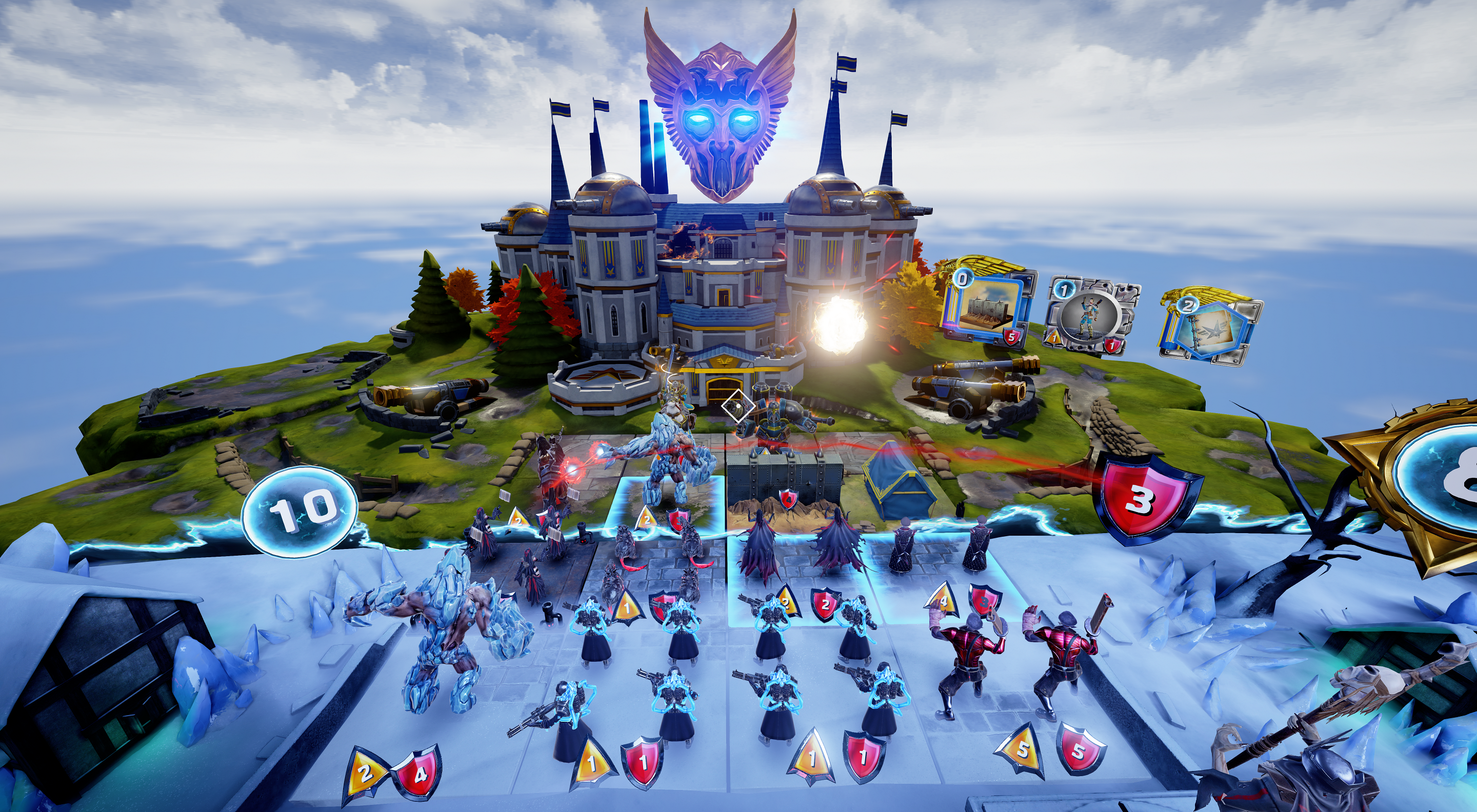
I’m sat on top of a castle looking over a gridded battlefield, with a menacing metal mask staring back at me from the fortress on the other side. Dragon Front, a free to play VR card game exclusive to the Oculus store, does a great job of making you feel more like the commander of an army than a card-slinger playing a deck-building game, but the usual mechanics are all here. Players spend mana to summon minions with different amounts of attack, health, and unique effects, and use them to lower their opponent’s life total to zero. But unlike Hearthstone or Magic: The Gathering, minions appear in a lane on the field below when they come into play, and have to fight their way across to the enemy’s castle to deal damage. It’s nothing we haven’t seen before, but it’s one of the cooler uses of VR I’ve seen so far.
While I only saw two of the four available factions, both were distinct and interesting. My faction was primarily made up of knights and “dieselpunk” machines like a brass-plated artillery cannon and an old-timey fighter plane, while I played against a creepier faction full of grim looking soldiers, a few vaguely-vampiric units, and a hulking Abomination. Developer High Voltage hasn’t exactly reinvented the wheel with its chosen themes, but it has put its own spin on them. Dragon Front has gone for a relatively cartoony aesthetic, and every minion has been modeled in 3D—moving about both on the battlefield and while still in the frame of their cards. Those details take advantage of the unique benefits of VR while making the game world feel more alive.
The UI leaves a bit to be desired in terms of how information is presented to you—which could be a big deal, since clarity and presentation can make or break digital CCGs. You can’t see what cards are in your hand at a glance, and pressing the button to pull them up obstructs your view of the board. Additionally, you need to enlarge each card to clearly read its text because the writing is too small to make out legibly otherwise. These aren’t huge problems, but it is awkward. Part of the joy of playing physical card games is feeling the paper in your hand, shuffling the deck, hearing the sounds the cards make as they are thrown on the table—and most of the challenge in transferring that experience to digital is making up for those losses.
However, one of the most exciting parts about Dragon Front is how it’s recreated a key piece lost in the translation from physical to digital: sitting across from your opponent. The mask that was staring at me from the other end of the table is mapped to my opponent, and I could watch it move as he looked around the board. If you see your opponent staring at one of your minions, you can guess he might be thinking about removing it. Seeing a representation of your opponent's face doesn’t have huge gameplay implications, but it goes a long way to restoring some of that tabletop magic—and I can’t wait to play Dragon Front against friends with VoiP, because then the conversation (read: trash talk) will return as well.

That said, I don’t know if I’m in a rush to play against random opponents. I’m concerned about the initially small card pool in Dragon Front, as the game will only launch with 240 cards. With 25 cards per deck and only 60 cards for each faction, it’s almost inevitable that the best decks for each of the factions are going to look incredibly similar. High Voltage told me it plans to add more cards to the game every couple of months which is encouraging to hear, as Dragon Front will need a quick influx of deck-building options or risk having an anemic metagame. Small card pools are a problem every new CCG has to overcome, but the issue might be exacerbated by this game’s faction-based limitations and small deck size. For comparison, Hearthstone launched with 378 cards spread across nine classes and a neutral set, and its card pool was still considered relatively small even after its first couple expansions.
It’s incredibly difficult (probably impossible) to judge the balance or longevity of any card game after playing only one match, but it can give you a feel for the mechanics—and I like what I played of Dragon Front. If nothing else, it’s a game that I’m glad exists this early in VR’s life, and I look forward to more “tabletop” VR games following its lead. The pacing and strategy of Dragon Front was fun—it didn’t blow me away, but there’s nothing else like it yet. That'll probably change, so Dragon Front will only be able to rely on the novelty of being the first VR card game for so long.
Keep up to date with the most important stories and the best deals, as picked by the PC Gamer team.


